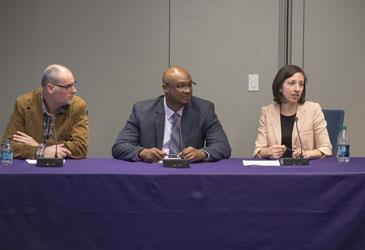Ensuring patients get equitable care is difficult if you aren’t sure who your patients really are. That’s why the Commission to End Health Care Disparities is investigating best practices in collecting race, ethnicity and preferred language data from patients in ambulatory settings. Three different practices share how they are making strides in collecting this data.
The three groups received recognition at the commission’s spring meeting in Chicago this past weekend for demonstrating how they collect race, ethnicity and language data and what they do with that data. The three groups demonstrated sustainable data collection efforts in ambulatory settings and can serve as models for other practices.
Henry Ford Health System
This southeast Michigan organization, consisting of five hospitals and 27 medical centers, took a scientific approach to incorporating race, ethnicity and language data. An interprofessional task force used the Institute of Medicine’s recommendations for how to collect the data and tailored those recommendations after receiving input from a series of diverse community focus groups.
Megan Brady, a project manager for the system’s Institute on Multicultural Health, said the task force discovered they were missing key components of race and ethnicity data.
“We had a very large Arab and Middle Eastern group that was not really captured,” she said. “[These groups were] categorized as white by the U.S. Census.”
After implementing staff and patient education, verbally collecting the data as well as using collection forms and providing ongoing staff training, the system has improved its collection efforts, now receiving the data from about 90 percent of patients.
“We realized that there were so many employees in our system that did not know that disparities exist,” Brady said. “We needed to work on that, we needed to raise awareness about existence of disparities. Nobody can be engaged to address them if they don’t even know they exist.”
Kelsey-Seybold Clinic
This large, multispecialty clinic servicing greater Houston in 2012 was the first to receive accreditation as an accountable care organization (ACO) from the National Committee for Quality Assurance. This designation sparked the organization to seek race, ethnicity and language data, discovering they had less than 60 percent of patients providing that data.
The organization decided to collect race and ethnicity survey cards at primary care visits across the system, providing training and suggested scripts to front desk staff.
“Before we started doing this, only the physician was allowed to collect racial data, said Leon Jerrels, director of quality improvement at Kelsey-Seybold. “So we changed how we do this… As an ACO, it’s important to collect this data to provide quality care for all patients. We put it out there and miraculously, there was an increase.”
After two years, the organization saw an upswing, with nearly 80 percent of patients offering the data. But data collection efforts began to sag.
“It was hard to maintain passion and drive [among staff] at all locations,” Jerrels said. “We needed to reeducate.” The organization is reevaluating its work and continuing its data collection push.
Providence Medical Group
This primary care and specialty medical group, with more than 140 clinics in Oregon and southwest Washington, serves a mix of urban and rural patients. The organization is highly driven by its mission: “Know me. Care for me. Ease my way.” In serving this mission, it was crucial to know the race, ethnicity and preferred language of patients, but they only had data on about 10 to 15 percent of patients, said Mitch Yoder, manager of health literacy innovation and integration at Providence Medical Group.
The organization tapped its diversity committee for help, forming a workgroup to determine how to improve data collection. In the end, the group created online training for clinic staff, developed an FAQ document for patients, incorporated information on the data into training for patient relations representatives and more. The organization now has data from 80 percent of patients.
“We’re using training and job aides,” Yoder said. “We’re incorporating scenarios into employee service excellence training. There’s a realization by staff that asking [patients for this information] is OK and not really that difficult, it’s more something [staff] need to get over.”
Now that these organizations have the data, they must determine how to use it to improve patient care. Providence is using its findings to change policies and practices and determine future hiring needs and health education topics. At Henry Ford, employees are using the data to form questions and clinical projects to address disparities.
“Don’t look at the data if you’re not ready to address anything that you find,” Brady said.




